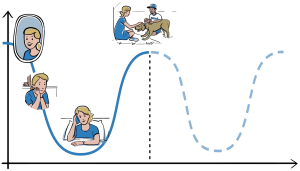Culture Shock Wave
 The term culture shock was coined by American anthropologist Kalvero Oberg in the 1960s. In his essay Practical Anthropology, Oberg looked at the experiences of students who spent a semester abroad. He analyzed the hurdles they faced in the foreign culture. In this context, he defined culture shock as a crisis with five phases: Euphoria, Alienation, Escalation, Misunderstanding, Understanding (cf. Oberg 1960, 177-182). Oberg’s theory has been modified and developed many times in the past decades. In this context, Pedersen should be mentioned, who extended Oberg’s culture shock definition to all systems perceived as foreign: „Culture shock happens inside each individual who encounters unfamiliar events and unexpected circumstances.“ (Pedersen 1995, 1)
The term culture shock was coined by American anthropologist Kalvero Oberg in the 1960s. In his essay Practical Anthropology, Oberg looked at the experiences of students who spent a semester abroad. He analyzed the hurdles they faced in the foreign culture. In this context, he defined culture shock as a crisis with five phases: Euphoria, Alienation, Escalation, Misunderstanding, Understanding (cf. Oberg 1960, 177-182). Oberg’s theory has been modified and developed many times in the past decades. In this context, Pedersen should be mentioned, who extended Oberg’s culture shock definition to all systems perceived as foreign: „Culture shock happens inside each individual who encounters unfamiliar events and unexpected circumstances.“ (Pedersen 1995, 1)
5 Phases
Adler also took Oberg’s ideas and modified them. He also divides culture shock into five phases (cf. Adler 1974, 22-49). He calls the first phase the honeymoon. It is characterized by anticipation and curiosity. Travelers euphorically make first contacts with the foreign culture. After more intensive contact with the new culture, the initial euphoria can turn into rejection, resulting in the rejection phase. Initial difficulties arise, often accompanied by communication problems. The otherness of the new culture is more often perceived as stressful and disturbing. This is followed by the third, so-called regression phase. This is the actual culture shock. The person withdraws and complains. In addition, one’s own culture is idealized. The third phase is experienced as a crisis. If the process is positive, the fourth phase of culture shock follows, accommodation. People adapt and increasingly understand and accept the new culture. In some cases, ways of thinking and acting are also adopted. The person feels increasingly integrated and at home. Once back home, there can be a return shock. This means that the person feels foreign in his or her own country. The phases just described are thus passed through again.
Confident handling
In a graphic progression, the ups and downs become a wave. This is why we speak of a culture shock wave. Not everyone experiences all the phenomena described in the above-mentioned phasing, and there are also differences in intensity. The practical use of the knowledge about the phenomenon of the culture shock wave lies in the fact that one can deal with a culture shock more confidently with oneself as well as with others.
Literature
Adler, Peter (1974): Beyond cultural identity: reflections on cultural and multicultural man. Topics in culture learning. 8th ed.
Oberg, Kalvero (1960): Cultural shock: Adjustment to new cultural enviroments. In: Gulick, John (ed.): Practical Anthropology and Practical Politics. Vol. 7, 177-182.
Pedersen, Paul (1995): The five stages of culture shock. Critical Incidents around the World. Vol. 25. Westport/ Conn: Greenwood Press.
